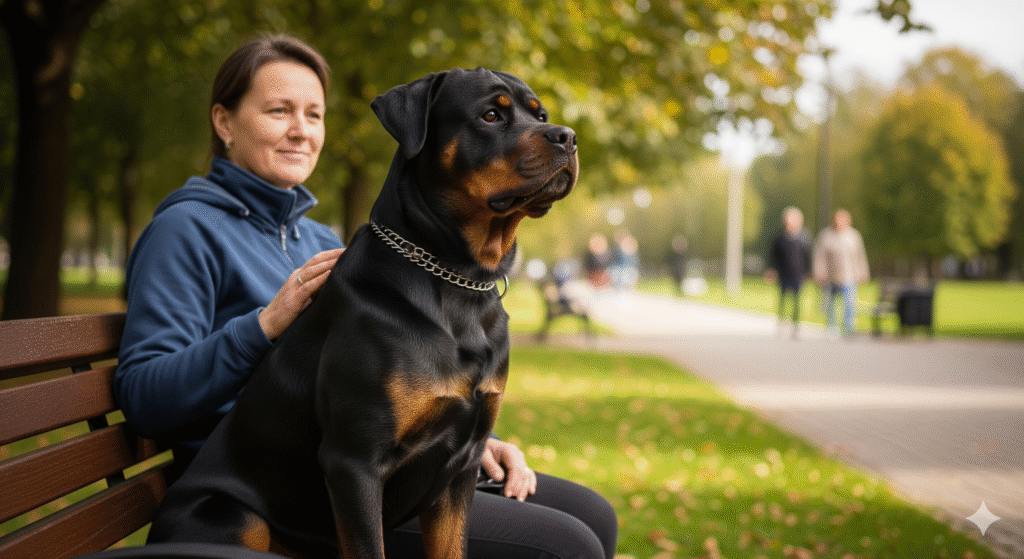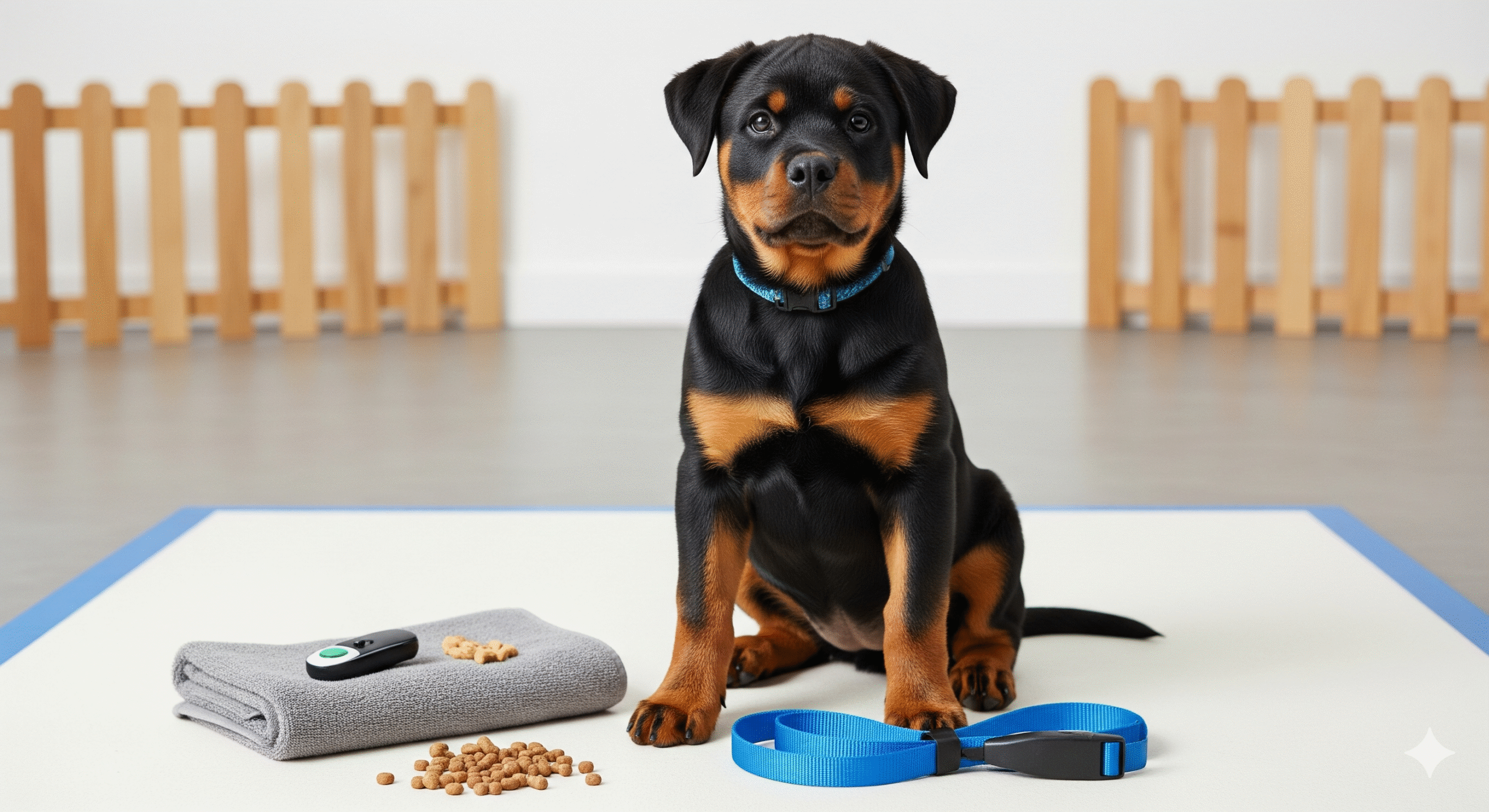Welcoming a Rottweiler puppy into your home is an exciting commitment to a powerful, intelligent, and deeply loyal breed. Renowned for their courage and confidence, Rottweilers possess a natural guarding instinct that must be carefully shaped through dedicated training and socialization. Without proper guidance, their strength and protective nature can become challenging; with it, they transform into the most devoted, stable, and well-mannered companions imaginable.
This comprehensive guide is tailored specifically to the unique needs of the Rottweiler puppy. We’ll provide you with the breed-specific knowledge and techniques to nurture their best qualities and ensure they grow into a dog you can trust completely.
Here’s what we’ll cover:
✔️ Understanding the Rottweiler temperament and why it demands specific training
✔️ Socialization strategies to prevent over-protectiveness and fear
✔️ Essential obedience commands for managing a powerful breed
✔️ How to establish yourself as a calm, confident leader
✔️ Common behavioral challenges and how to address them early
✔️ Creating a lifetime bond built on mutual respect and trust
Let’s embark on the rewarding journey of raising a well-adjusted Rottweiler.
Understanding the Rottweiler Temperament: More Than Just a Guard Dog 🧠
To train a Rottweiler effectively, you must first understand what drives them. They are a working breed through and through.
- Confident & Courageous: Bred for driving cattle and guarding homesteads, they are naturally bold and self-assured. They are not typically nervous or skittish.
- Loyal & Family-Oriented: They form intense, protective bonds with their family and are often aloof with strangers—a trait that must be carefully managed.
- Intelligent & Trainable: Ranked among the most intelligent breeds, they learn quickly and thrive when given a job to do. Boredom is your enemy.
- Strong-Willed & Powerful: They possess immense physical strength and a independent mind. They will test boundaries and require a handler who is consistently firm and fair.
The key to a good Rottweiler is channeling their natural instincts into appropriate behaviors through leadership and training.
The #1 Priority: Early and Extensive Socialization 🌍
For a breed with guarding instincts, socialization is not optional—it is a critical necessity. The goal is to build their confidence and teach them how to discern normal, non-threatening situations from real danger.
Socialization Goals for a Rottweiler Puppy:
- People: Expose them to 100+ people by 16 weeks, including men, women, children, people wearing hats, uniforms, sunglasses, and using mobility aids like wheelchairs or canes.
- Environments: Take them (safely, before full vaccination) to parks, urban streets, pet-friendly stores (while carried), and quiet parking lots. Let them experience different surfaces like grass, gravel, metal grates, and wooden decks.
- Sounds: Play recordings of thunderstorms, fireworks, traffic, and children playing at a low volume, pairing the sounds with high-value treats.
- Animals: Arrange controlled playdates with stable, vaccinated, and friendly adult dogs who can teach good manners.
Pro Tip: Always pair new experiences with something positive like chicken or cheese. You want your Rottweiler to associate novel things with good outcomes.
Rottweiler Puppy Training Fundamentals 🎓
Training should begin the day you bring your puppy home. Their intelligence means they are always learning, whether you are actively teaching them or not.
1. Establish Leadership with Respect, Not Fear 🧘♂️
Rottweilers require a confident leader. This does not mean being harsh, loud, or physical.
- Control resources (food, toys, doorways) in a calm, predictable way.
- Set clear rules and boundaries and enforce them consistently.
- Use a calm, firm tone. They respond poorly to yelling or nervous energy.
- Practice “Nothing in Life is Free”: Ask your puppy to perform a command (like “sit”) before receiving meals, treats, toys, or affection.
2. Essential Obedience Commands 🗣️
These commands are crucial for managing a powerful dog.
- Sit/Stay: For impulse control and calm greetings.
- Rock-Solid Recall (“Come”): An emergency brake. Practice in increasingly distracting environments with ultra-high-value rewards.
- “Leave It”: Critical for preventing them from picking up dangerous items.
- “Place” or “Mat”: Teaches an off-switch and gives them a job to settle down on their bed.
3. Leash Training & Loose-Leash Walking 🦮
A pulling Rottweiler is unmanageable. Start early.
- Use a front-clip harness for better control and to discourage pulling.
- Stop moving the instant the leash gets tight. Only proceed when the leash is slack.
- Reward heavily for walking nicely beside you.
Addressing Common Rottweiler Behavioral Challenges ⚠️
1. Resource Guarding 🦴
- Prevention: Hand-feed meals, trade up for higher-value items, and teach your puppy that you approaching their food or toys is a good thing.
- Never punish a growl; it is a warning. Instead, identify the trigger and manage the environment.
2. Over-Protectiveness & Alert Barking 🚨
- Manage the environment: Use window film to block views of the street if they bark at passersby.
- Teach a “Thank you” cue: Acknowledge the alert (“Thank you”), then ask for an incompatible behavior like going to their “place” for a treat. This channels the instinct into a controlled action.
3. Mouthing & Chewing 💪
- Rottweilers are powerful chewers. Provide a rotation of approved, durable chews (like Benebones, GoughNuts, or frozen Kongs).
- Redirect inappropriate chewing onto toys immediately.
Advanced Training: Channeling Their Instincts 🏆
Rottweilers excel in structured activities that engage their body and mind. Consider pursuing:
- Advanced Obedience: Earning a Canine Good Citizen (CGC) title is a fantastic goal.
- Schutzhund/IPO: This sport is tailor-made for breeds like Rottweilers, testing tracking, obedience, and protection work in a controlled environment.
- Agility or Carting: Excellent outlets for their energy and intelligence.
Final Tips for Success 🌟
- Start Early: Begin training and socialization at 8 weeks old.
- Be Consistent: Everyone in the household must enforce the same rules.
- Use High-Value Rewards: Their motivation to work is often food-driven. Use real meat, cheese, or hot dogs for important training.
- Keep Sessions Short & Positive: 5-10 minute sessions multiple times a day are more effective than one long, tedious session.
- Patience is Key: They are smart but can be stubborn. Stay patient and consistent.

Want to Understand Your Puppy’s Leptospirosis Risk? This article provided a brief overview, but lepto is a complex disease whose prevalence is increasing in many areas. Making an informed decision about vaccination requires understanding the local risks and how the bacteria spreads. For a deep dive into the subject, your next read is: Leptospirosis in Puppies: Risks & Prevention.






